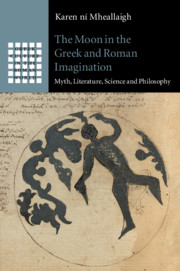Book contents
- The Moon in the Greek and Roman Imagination
- Greek Culture in the Roman World
- The Moon in the Greek and Roman Imagination
- Copyright page
- Dedication
- Contents
- Acknowledgements
- Abbreviations, Text References and Translations
- Part I The Moon in the Mythic Imagination
- Introduction
- Chapter 1 The Moon in Ritual, Myth and Magic
- Part II The Moon in the Scientific Imagination
- Part III The Moon in the Fantastic Imagination
- Bibliography
- Index
- Index Locorum
Introduction
To the Moon! Journey into the Ancient Scientific Imagination
from Part I - The Moon in the Mythic Imagination
Published online by Cambridge University Press: 09 October 2020
- The Moon in the Greek and Roman Imagination
- Greek Culture in the Roman World
- The Moon in the Greek and Roman Imagination
- Copyright page
- Dedication
- Contents
- Acknowledgements
- Abbreviations, Text References and Translations
- Part I The Moon in the Mythic Imagination
- Introduction
- Chapter 1 The Moon in Ritual, Myth and Magic
- Part II The Moon in the Scientific Imagination
- Part III The Moon in the Fantastic Imagination
- Bibliography
- Index
- Index Locorum
Summary
In the Apollo era, photographic images revealed the lunar landscape to us for the first time. Overnight, our mysterious opaline luminary – the fanciful home of insectoid Selenites, bat-men or benevolent lunar spirits – became a rock in space, a forlorn and uninhabited outpost of our world. But the ancient Greeks and Roman did not know this yet: they did not know what the Moon was made of (fire? ice? cloud?), or what caused it to change its shape each month, and they were fascinated by it – ‘haunted by its thereness’, to paraphrase John Updike, in a poem about the mysterious lunar presence.
- Type
- Chapter
- Information
- The Moon in the Greek and Roman ImaginationMyth, Literature, Science and Philosophy, pp. 3 - 7Publisher: Cambridge University PressPrint publication year: 2020

